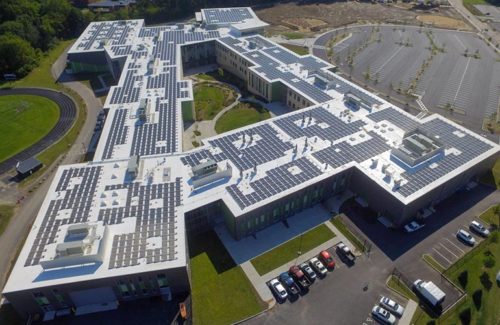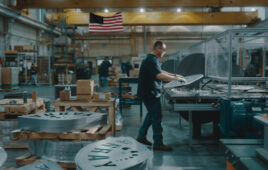Dover High School & Career Technical Center was a building 10 years in the making. Its doors opened for the first time to 1,476 students for the 2018-2019 school year after a decade of navigating proposals, planning, permitting, board review and construction. The final touch on the prolonged project was a yet-to-be-installed rooftop solar system.
During the first official school year in the new school, students saw equipment hoisted to the rooftop, where installers were setting up 2,851 solar panels that would account for 40% of the building’s electricity needs.

Dover High School & Career Technical Center’s dynamic rooftop hosts a 912-kW, net-metered solar system. Developers ReVision Energy had to wait until construction on the new school was completed, and leap over permitting hurdles from the district and city before installing any solar. ReVision Energy
Building a cleaner school
ReVision Energy developed and designed the 912-kW solar array occupying the rooftop of Dover High School and Dover Regional Career Technical Center in Dover, New Hampshire. The Northeast solar company subcontracted Ayer Electric, whose headquarters is just 20 minutes west of Dover, for construction of the system. Both Ayer and ReVision have employees who graduated from the school district, taught there or have children currently enrolled.
“We live in these communities. We feel a connection to many of the projects we do personally around the state and that was very much true of Dover,” said Dan Weeks, director of market development at ReVision Energy.
The former Dover High School was built in the 1960s and was in dire need of repairs. The city determined it was more cost-effective to rebuild rather than renovate, so a new 100,000-sq.-ft larger school was designed and equipped with modern necessities like energy-efficient lighting, air conditioning and dehumidifiers. Nothing could be installed on the school’s rooftop until after the general contractor completed construction of the building and placement of the new HVAC system. Prior to even breaking ground on the new school, ReVision used GPS coordinates, drone imaging and building blueprints to design a solar system for a building that didn’t exist yet.
“Unfortunately, nobody ever thinks about putting solar on the roof,” said Marc Wiemer, project manager at Ayer Electric.
But in the case of the new Dover High School, it was designed to support the weight of a ballasted solar array, and the electrical infrastructure of the building was ready for connection to solar. The roof itself posed some navigational challenges for the installers, since the building varies between a two- and three-story height, and the building footprint is square, with an open-air courtyard in the center.
Solar construction began in January 2019, just as students were entering their second semester. Cranes had to be brought in during off-hours, weekends and holidays to lift equipment to the rooftop to leave school bus routes uninterrupted. Components were dropped off in four segments and staged from there, because structurally the rooftop couldn’t handle the entire project load at a single point. Ayer’s installers used a Garlock Equipment power jack to safely, and as quietly as possible, move components across level sections of the rooftop.
The solar system uses REC 320-W N-Peak panels, seven SolarEdge 100K 3-phase inverters, Ecolibrium Solar’s EcoFoot2 flat roof ballast racking and a Locus L Gate 360 monitoring system.
“All the students were in place. They had buses coming in and out, trying to get deliveries. There’s a road going all the way around, so that means the entire perimeter of the school is being used at all times,” Wiemer said. “Now, we also have a construction project going on during classes, so not only that, we’re trying to make sure that noise and interruptions to the school are at the absolute minimum.”

Subcontractor Ayer Electric installed the solar system on a rooftop that varied between two and five stories high. ReVision Energy
Since the system would use ballast, crews did not want to void the warranty of the Sika membrane. So, slip sheets of the same Sika material had to be purchased and laid underneath every ballast foot for extra layering for the weighted mounting solution to qualify for the warranty.
In addition to the extra precautions, crews had to navigate subzero temperatures and heavy snowfall that delayed installation until March.
“We did get a fair amount of snow, which we had to work around or let it melt,” Weeks said. “Definitely below freezing temperatures, which is something our crews deal with throughout winter, so this was no exception. They had some weather to deal with, but they soldiered through.”
The system officially came online in September 2019.
Design and permitting hurdles
When the City of Dover initially requested plans for a solar array on the school in 2018, it asked for a more modest 400-kW design.
“We wanted to provide what they were looking for in the form of a 400-kW design, but also just felt that there was a really good opportunity based on our understanding of net metering to max out that roof,” ReVision’s Weeks said. “We knew that it was designed to accommodate solar across the entire structure, and so we included a full-sized design at 912-kW, which they ultimately went with.”
New Hampshire net metering caps off at 1,000 kW for commercial customers and 100 kW for smaller, residential systems. The original vision for the array didn’t include any export of electricity, but schools have fluctuating energy needs throughout the year, where the facilities wouldn’t be used as much during summer months.
“We [requested] a baseline system that had been suggested by a consultant that we had brought on previously. The concern was the lack of net metering in this state and some of the regulatory impediments that the state has put in place,” said Chris Parker, assistant city manager. “So, ReVision, when they bid on it, said we could do the smaller system, but they said the larger system would still meet the regulatory framework but also provide a much better opportunity. That’s why we went with the larger array.”

Construction of the solar system on Dover High School didn’t start until after classes began, so cranes had to be brought in during off hours to hoist equipment to the school’s rooftop. ReVision Energy
Before any solar could be installed, plans had to be approved by both the school board and city council. Both the school and the city had a say in the permitting because it was a school district-owned building residing on public land.
“New Hampshire is not the only state this way, but we’re a bit famous as the ‘Live Free or Die’ state, for our local system approach, where you’ve got a lot of different entities claiming at least partial jurisdiction over projects of this nature,” Weeks said.
The high school array was financed through a power purchase agreement with the city, and after 10 years of operation, Dover has the option to buy the solar system.
“The community in general has been looking at ways to implement solar options on municipal buildings and looking at ways to be more mindful of our environment and our impacts on the environment,” Parker said.
Weeks said that a small experienced labor pool has slowed ReVision’s growth but installing solar systems for settings like technical schools, where electrical training is offered, might encourage students to seek a career in solar.
A school official said the array isn’t implemented into any official curriculum at Dover High School yet, but it has been part of conversations on subjects of climate issues and local government, and the school’s Eco Club participated in the array’s ribbon-cutting ceremony back in September.
Pictures of Dover High School’s rooftop solar system are featured in the building’s main lobby alongside how much power it’s producing.
“Early solar was done for rich people and environmentalists,” Weeks said. “God bless them for being early adopters, but we really wanted to move beyond that, and particularly make solar accessible to public sectors and nonprofits. We also felt we could, over time, develop a market and provide to the local school.”
Corrections were made regarding Dover High School & Career Technical Center’s rooftop and electrical infrastructure on May 7, 2020.




This is a great project, well pre-planned and well managed. How I wish I can be part of the team that do the installation. Hopefully someday I can achieve my dream in solar system installation.
And then there is that enormous black tarmac of a parking lot. Could at least a part be used to place to store the energy generated when school is off? I would use in combination with Liquid air energy storage, using the air as a coolant for all electrical equipment/building during summertime.
Including batteries would be a great use case here, because they would be fully charged on weekends and compensate for the lacking power during weekdays.